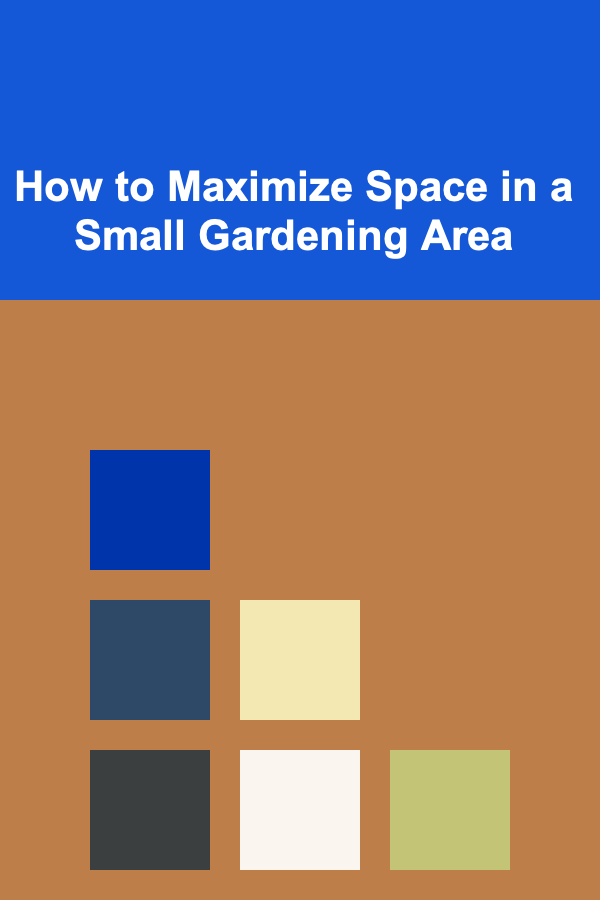
How to Maximize Space in a Small Gardening Area
ebook include PDF & Audio bundle (Micro Guide)
$12.99$9.99
Limited Time Offer! Order within the next:

Creating a flourishing garden in a small space can be both a challenge and an art form. With strategic planning and creative solutions, it is entirely possible to maximize the available area, allowing you to enjoy the beauty and benefits of gardening even in confined spaces. This comprehensive guide will explore various techniques and ideas for optimizing space in a small gardening area, covering everything from vertical gardening to container planting and beyond.
Understanding Your Small Gardening Area
Before implementing strategies to maximize space, it's essential to understand the specifics of your gardening area.
Space Dimensions
Measure your gardening area accurately. Take note of dimensions, including height, width, and any obstacles like fences or trees that may affect sunlight exposure.
Soil Quality
Assess the soil quality. Good soil is critical for healthy plant growth. If soil quality is poor, consider strategies like raised beds or containers.
Accessibility
Evaluate how easily you can access different parts of your garden. Proper accessibility will make maintenance easier and enhance your gardening experience.
Assessing Sunlight and Climate
Sunlight plays a crucial role in gardening success.
Sun Exposure
Determine how much sunlight your garden receives daily:
- Full Sun: 6+ hours of direct sunlight.
- Partial Shade: 3-6 hours of sunlight.
- Full Shade: Less than 3 hours of sunlight.
Knowing this will help you choose suitable plants and plan their placement effectively.
Microclimates
Identify any microclimates within your small space. Areas close to walls, fences, or structures may have different temperatures or moisture levels than open areas.
Choosing the Right Plants
Selecting the right plants is fundamental to maximizing a small gardening area.
3.1 Compact Varieties
Opt for compact or dwarf varieties of plants. These smaller versions still provide blooms and foliage but occupy less space.
- Examples: Dwarf fruit trees, mini roses, and compact shrubs.
3.2 Perennials vs. Annuals
Consider incorporating perennials into your design. While they may take longer to establish, they will come back year after year, allowing for more efficient space usage over time.
- Perennials: Hostas, daylilies, and lavender.
- Annuals: Marigolds, petunias, and zinnias can be rotated throughout the seasons.
3.3 Edible Plants
Growing your own food not only maximizes space but also adds functionality to your garden.
- Space-Saving Edibles: Herbs like basil and thyme, compact vegetable varieties (like cherry tomatoes), and leafy greens such as lettuce can fit into tight spaces easily.
Vertical Gardening Techniques
Vertical gardening is an excellent way to maximize limited ground space.
4.1 Wall Planters
Wall planters allow you to utilize vertical surfaces by attaching pots or pockets directly to walls or fences.
- Materials: Wood pallets, metal grids, or ready-made wall planter systems can work well.
4.2 Vertical Gardens
Create living walls with climbing plants or specially designed vertical garden systems.
- Climbers: Use plants like peas, cucumbers, or ornamental vines that grow upwards, saving horizontal space.
4.3 Hanging Baskets
Hanging baskets can host flowers or trailing plants, freeing up ground space.
- Placement: Hang them from hooks, rafters, or pergolas to create a dynamic look.
Container Gardening Solutions
Container gardening is an effective strategy for maximizing space while allowing for flexibility.
5.1 Types of Containers
Explore various container types tailored to specific needs:
- Traditional Pots: Terracotta or ceramic for aesthetics.
- Fabric Pots: Great for drainage and root health.
- Self-Watering Containers: Useful for reducing maintenance and ensuring consistent moisture.
5.2 Container Arrangement
Strategically arrange containers to make the most of your space:
- Layering: Place taller plants in back and shorter ones in front for visual appeal.
- Grouping: Keep similar plants together for care efficiency and aesthetic coherence.
5.3 Soil and Drainage Considerations
Use high-quality potting soil and ensure proper drainage in containers to promote healthy plant growth. Drilling holes at the bottom of containers or using container liners can prevent waterlogging.
Using Raised Beds and Troughs
Raised beds are an excellent solution for gardening in small spaces, especially if soil quality is poor.
Benefits of Raised Beds
- Improved Drainage: Raised beds tend to drain better than traditional gardening plots.
- Soil Control: You can customize the soil mix according to your plants' needs.
- Accessibility: Easier access for planting and maintenance, reducing strain on the back.
Troughs as Alternatives
Repurpose old troughs or large containers to create additional planting spaces. They provide good depth for root growth and can be arranged vertically or horizontally.
Creative Paths and Walkways
In tight spaces, pathways are essential for accessibility but can also be creatively used to maximize planting areas.
Designing Pathways
- Narrow Paths: Create narrow paths between planting areas to save space while allowing for easy movement.
- Material Choices: Utilize gravel, wood chips, or stepping stones to define paths without taking up too much room.
Multi-Functional Spaces
Consider designing paths that double as planting areas. For example, edging along a path can feature low-growing herbs or flowers.
Utilizing Edges and Corners
Maximize every square inch of your gardening area by utilizing edges and corners.
Corner Planters
Use corner spaces for tall plants or vertical installations. This approach draws the eye upward, creating the illusion of more space.
Edge Planting
Plant along fences or walls with a combination of climbers and low-growing plants to add depth and texture.
Incorporating Garden Furniture
In small gardens, furniture should complement your space rather than detract from it.
Choose Modular or Foldable Furniture
Select modular seating options that can be rearranged easily, or foldable furniture that can be stored away when not in use.
Multi-Functional Pieces
Consider benches with built-in storage for tools or cushions, allowing you to combine function with comfort.
Planning Seasonal Rotations
Rotating plants seasonally helps maintain soil health and allows you to maximize your gardening space throughout the year.
Crop Rotation Principles
Implement crop rotation principles to prevent nutrient depletion and reduce pests and diseases. This practice is particularly beneficial for edible gardens.
Seasonal Planting Plans
Create a seasonal planting calendar to manage what to sow and when, ensuring continuous growth and harvest throughout the year.
Maintenance Tips for Small Gardens
Maintaining a small garden is crucial for its longevity and productivity.
Regular Weeding
Small gardens can quickly become overrun with weeds. Schedule regular weeding sessions to keep plants healthy and thriving.
Efficient Watering
Use drip irrigation or self-watering systems to minimize water waste and ensure consistent moisture.
Fertilization
Pay attention to fertilization practices based on your plants' needs. Organic fertilizers can be particularly effective in small gardens.
Conclusion
Maximizing space in a small gardening area requires creativity, strategic planning, and continued care. By understanding your space, selecting the right plants, and utilizing innovative gardening techniques such as vertical gardening and container solutions, you can create a beautiful and functional garden even in limited areas.
With thoughtful organization and regular maintenance, a small garden can flourish and provide joy, beauty, and even sustenance. Embrace the challenges of gardening in confined spaces, and let your creativity thrive as you transform your small area into a vibrant oasis!

How to Allocate Funds for Entertainment and Leisure
Read More
How to Create a Yearly Maintenance Plan for Your Home
Read More
How to Create an Efficient Home Workout Storage Solution
Read More
How to Develop a Mindful Approach to Exercise
Read More
How to Establish a Monthly Savings Habit
Read More
How to Leverage Local Events for Your Yard Sale Timing
Read MoreOther Products

How to Allocate Funds for Entertainment and Leisure
Read More
How to Create a Yearly Maintenance Plan for Your Home
Read More
How to Create an Efficient Home Workout Storage Solution
Read More
How to Develop a Mindful Approach to Exercise
Read More
How to Establish a Monthly Savings Habit
Read More